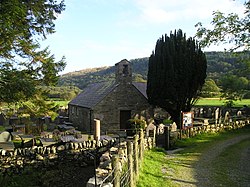Capel Curig
| Capel Curig | |
| Caernarfonshire | |
|---|---|
 St Julitta's Church | |
| Location | |
| Grid reference: | SH720582 |
| Location: | 53°6’18"N, 3°54’47"W |
| Data | |
| Population: | 226 (2001) |
| Post town: | Betws-y-Coed |
| Postcode: | LL24 |
| Dialling code: | 01690 |
| Local Government | |
| Council: | Conwy |
| Parliamentary constituency: |
Meirionnydd Nant Conwy |
Capel Curig is a small village and parish in Caernarfonshire, lying in the heart of Snowdonia. It stands on the River Llugwy, and had a population of 226 in 2001.
The village is at the junction of the A5 trunk road from Bangor and Bethesda to Betws-y-Coed with the A4086 from Caernarfon, Llanberis, Pen-y-Pass and Pen-y-Gwryd.
Capel Curig is recorded as being as the wettest place in the British Isles,[1] although the weather station is in Dyffryn Mymbyr, a couple of miles out of the village, in the direction of Snowdon.
Name
The name of Capel Curig means "Curig's Chapel" and takes its name from the little Church in the ancient graveyard by the river bridge on the Llanberis road. This church has been known for over 100 years as St Julitta's Church and is currently being restored by the "Friends of Saint Julitta", but tradition claims this chapel to be the 6th century foundation of St Curig, a bishop.
Centuries after Curig's days, probably when the present ancient church was built, the name appears to have been Latinised as Cyricus, which is also the name of a 4th-century child martyr whose mother was Julitta. They are usually named together as Saints Quiricus and Julietta.
Evan Roberts
Capel Curig was home to one of the finest examples of a self-taught botanist in Britain; Evan Roberts.[2] Evan Roberts lived at Gelli in Capel Curig where he lived and would explore all of Snowdonia, and in doing so compiled an unparalleled knowledge of the plant life in North Wales. Although he spent the first 40 years of his life as a quarry worker, he went on to become the colleague of academics. He was awarded the honorary degree of MSc of the University of Wales, in 1956, at the same ceremony as the architect Frank Lloyd Wright, and his portrait was painted by Kyffin Williams.
Roman Fort
Less than a mile beyond Pont Cyfyng, towards the south east end of Capel Curig, on the farm of Bryn Gefeiliau there are the remains of a Roman fort dated to around 90-100 AD and named Caer Llugwy by its excavators.[3] In 1920 excavations undertaken by J.P. Hall and Captain G.H. Hodgson revealed a roughly square Roman fort of approximately 4 acres. Some stone buildings were uncovered and traced.
Activity centre
The village is a popular centre for walking, climbing, mountaineering, mountain biking and other outdoor pursuits and is served by the Sherpa bus network. It is also home to a youth hostel, [Army training camp, a camp site, several cafés and hotels and outdoor activity gear shops.
Wolverhampton City Council have since 1961 operated 'The Towers' outdoors activity centre just outside of Capel Curig. The centre facilitates walking, climbing, a variety of watersports and field studies on a schdule that is adapted day to day according to the prevailing weather conditions and to the abilities and needs of individuals and groups.
Also located in Capel Curig is the UK National Mountain Centre at Plas y Brenin, which offers the highest quality mountaineering, climbing, canoeing facilities and training. One mile east of the village on the A5 is Ty Hyll, home of the Snowdonia Society
Outside links
- Capel Curig - Village Website
- Plas y Brenin - National Mountain Centre Website
- A history of the village
- www.geograph.co.uk : photos of Capel Curig and surrounding area
References
- ↑ Wild About Britain - weather records
- ↑ Robin Gwyndaf (2006). The Mountain Man. A portrayal of Evan Roberts, Capel Curig, rockman, botanist and conservationist. Capel Curig: Friends of St. Julitta's Church. ISBN 0-9552995-0-0.
- ↑ J.P. Hall (November–December 1923). Caer Llygwy: the Roman Fort between Capel Curig and Betws-y-Coed. vol. 37. 186.